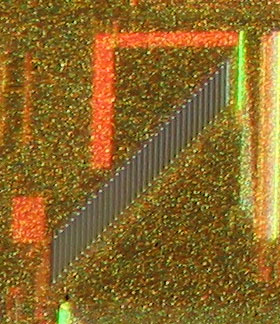
As can be seen in the drawinng above of the 7D SIR lens module, it has to cover more AF pixel array areas on
the AF sensor below, and thus contains more lenses than its 5D counterpart. The SIR lens configuration is thought
to be very similar to the Canon 40D, 50D and 60D

The dark lines are the arrays of light sensitive AF pixels. The remainder are structures of the read out circuitry, etc.

By looking at the AF sensor under the microscope a lot more detail starts to appear. The individual AF pixels
are rectangular and by using the overloy scale the size of the individual AF pixel can be determined to be
14.3 x 125µm, or about 40 times the area of an average image sensor pixel (6 - 7µm)

Looking even closer at the lower left corner diagonal f/2.8 sensitive array, contrary to commen belief, it is
obvious that the AF pixels are not aligned with the array direction, but are composed of staggered vertical
pixels. This is true for the upper right array as well. The pixels of the lower right and upper left diagonal
f/2.8 arrays similarly house horizontally staggered AF pixels. The number of AF pixels in the arrays vary, but
for the diagonal arrays the number is 32. The spacing between the (black) pixels are “dead zones”.
Theoretically a very thin line could be projected onto such a dead zone - one reason that the central f/5.6
horizontally sensitive AF points reality consist of double pixels housed in two approx. ½ pitch offset, staggered
vertical arrays (as seen on the top image above)
Further details about how the AF arrays map onto the AF points can be found in patent US8063977B2. Details
about the benefits of ½ pitch offset can be found in patent US7515819B2
| 

